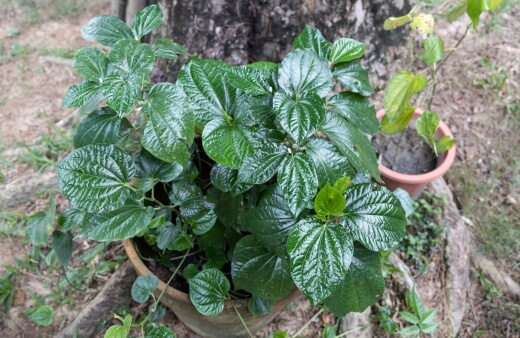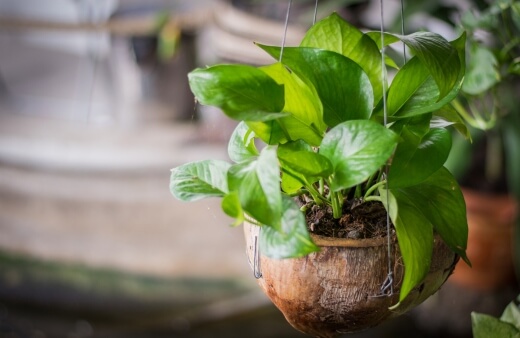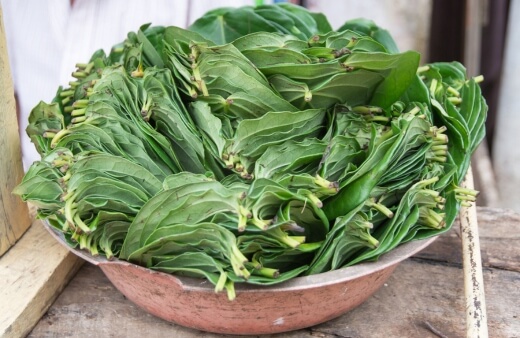I am continually amazed at the natural resources of this world, and how plants have the ability to provide so much goodness. The betel leaf plant is a perfect example of this, offering nutrition and healing, while being a good looking addition to a garden or pot.
We’ve got plenty to share in this guide about the goodness of betel leaf, when it’s used for both medicinal and culinary purposes. We’ll talk you through how to propagate and how to care for your betel leaf plant, along with how to handle pesky pests and diseases.
More...

Family: | Piperaceae |
|---|---|
Genus: | Piper |
Species: | P. sarmentosum |
Common Names: | Betel Leaf, Piper Betel Leaf |
Origin: | Thailand and Vietnam |
Location: | Outdoor and indoor |
Type: | Creeper |
Growth: | Up to 15 cm tall and 11 cm wide |
Sun requirements: | Shade with indirect light |
Foliage Colour: | Green |
Flower Colour: | White |
Flowering: | Spring in their second year |
Fruit: | Red, fleshy berries that can be eaten, sweet and jelly-like |
Maintenance level: | Average |
Poisonous for pets: | Yes |
Introduction Betel Leaf Plant
The betel leaf plant is part of the pepper family, and provides a wealth of value for both culinary and medicinal use. The leaves are shiny with a heart shape and work quite well in pots. The evergreen creeper also produces tiny white flower spikes followed by a fruit much like mulberry.
The betel leaf part is an important part of Indian culture. It is used for religious events but also as a mouth freshener. The sheaf of betel leaf is given to elders in a family to show respect during festivals and important events. It is often called ‘paan’ in Hindi.
Betel leaf or paan along with betel nut is often used as a wedding invite, and in Bengali culture, the bride makes her entrance wearing two betel leaves over her face as a covering.
Growing Betel Leaf Plant in Australia
If you live in an area that is prone to frost, you’ll be glad to know that the betel leaf plant is quite frost tolerant once it has established itself. In areas with a climate that resembles tropical, you can use betel leaf as a ground cover.
For those living in colder regions, perhaps opt to grow it in a hanging basket or pot so you can move it to warmer and more sheltered spots during the wintertime.

Propagating Betel Leaf
Betel leaf plants can easily be propagated with cuttings taken during spring. Aim for a length of 15 cm and make the cutting at an angle and just underneath a leaf node. You can remove most of the leaves and just leave about 3 at the top of the cutting.
Put the cuttings in a bottle with water and put it somewhere with good lighting to help roots to grow. Once you see roots, you can then plant the cuttings in a deeper container and make sure you use a soil mixture that is well-draining.
You can plant the cuttings to a depth that is at least half the cutting length and the soil needs to be kept moist. It might reach a point where you need to repot your betel leaf plant.
When to Repot Betel Leaf
If your plant container looks full of roots or they’re peeping out of the drainage holes or above the soil, this is a good indication that it needs a bigger space to grow. Aim to transplant your betel leaf plant into a container or pot that is at least 10 cm bigger than the current one.
Be gentle when removing the plant and try to get the roots loose by removing some of the soil. Be very careful not to cause any root damage. When you do the transplanting, be sure to use a new potting mix that is also well-draining.
Caring for Betel Leaf
The betel leaf plant doesn’t need large amounts of care. Being a creeper, it can be grown on a trellis or in a hanging basket or planter.

Soil
Betel leaf likes a rich soil but it does need to be well-draining. The plant doesn’t like to be dry but it doesn’t want to sit in water either. If planting in a pot, make sure it’s deep enough with plenty of draining holes.


Get Your Free Guide:
Master Growing Australian Natives eBook
A Must Have Complete Guide for Every Australian Garden
Get Your Free Guide:
Master Growing Australian Natives eBook
A Must Have Complete Guide for Every Australian Garden
You can fill it with a mixture of normal soil from the garden and then add coco peat and compost.
Light
The betel leaf plant loves its shade and a bit of light. For plants grown outside, you can aim to plant it somewhere that is shaded by bigger trees. For indoor growth, you can choose a spot in your home that gets bright and indirect light the entire day.
Water
You’ll need to water your betel leaf often enough to make sure the soil stays moist but never soggy. During the summer time you might need to water every day, and then in the winter season you can reduce this.
Fertiliser
Feeding your betel leaf plant is a must. You’ll notice that it grows bigger leaves and the stems get thicker too. You can aim to feed your betel leaf every few months during the growing season using a nitrogen-rich fertiliser.
Pruning/Harvesting
You are able to harvest the leaves of your betel plant from December through to May. You can remove the outer leaves which are also larger. The smaller ones should be left to grow further. By harvesting the leaves often, the betel leaf plant is encouraged to grow even more.
Betel Leaf Pests and Diseases
Betel leaf plants can end up under attack from red mites. If this happens, you can treat by removing the mites and follow up with neem oil that can be sprayed onto the plant. Leaf blight is another thing to look out for.
It creates patches on the leaves that are either black or brown and they are oily. Treatment is quite simple and you can just prune off the leaves that are infected.
Betel Leaf Bush Tucker Guide
Betel Leaf Culinary Uses
Betel leaf is a staple part of cooking in Southeast Asia. Since the leaves are nice and spicy, they can be used both raw and cooked. The leaves can be used in a salad or to make wraps with different fillings.
This is especially popular in Thailand using peanuts, lime and ginger. The flower spikes of the betel leaf plant transform into a type of seed or fruit which looks a bit like mulberry. It’s sweet and has a texture like jelly.
Aside from its culinary use, betel leaves have some incredible health benefits. For a start, they are packed with vitamin C, niacin, and calcium. Below are some of the common ailments treated with the betel leaf.

Medicinal Benefits
Betel leaf works really well as a painkiller and brings relief almost instantly. It’s used to treat cuts and bruises, and is usually made into a paste and then applied directly. Betel leaf is used to reduce joint pain too.
The leaves contain anti-inflammatory properties and can provide comfort for those suffering from arthritis or osteoporosis. A bunch of fresh betel leaves is warmed and then tied nice and tight around the affected area.
If you’re struggling with constipation, betel leaves are full of antioxidants that help to clean out the body. It works by restoring the body’s pH levels, and will soothe any tummy upsets. The leaves can be crushed and then placed in water for a day.
You can then drink the water, preferably on an empty stomach. While we’re on matters of the stomach, betel leaf can improve digestion. It protects the gut, increases metabolism, and helps the body to absorb the nutrients it needs.
Looking for a natural way to treat a cold? Betel leaf can help with congestion in the chest and lungs. It can be applied directly to the chest by adding mustard oil to the leaves and warming them before application.
Alternatively, boil the leaves with cardamom, cloves and cinnamon, and then sip this mixture 3 times per day to help with any breathing issues. Betel leaves are known for having both antiseptic and antifungal properties.
Chewing Betel Leaf Paste
A paste made with the leaves can kill off fungal infections and is a great protector from germs. For this same reason, betel leaves are used for oral health. This is achieved by chewing betel leaf paste after a meal to maintain healthy gums and prevent bad breath. The paste is also great for healing toothache and mouth infections.
There is positive evidence to support that betel leaf can help to lower blood sugar in diabetic patients. The antioxidant leaves help to protect the body from the stress and inflammation that happens when blood glucose levels are dangerous.
Betel leaves contain lots of phytochemicals which means this amazing plant can help to fight cancer too. Chewing betel leaves is a great way to improve mood and to help fight depression as it stimulates the central nervous system. This plant certainly packs a punch from a wellbeing perspective.
For more bush tucker guides, check out our guide to growing and caring for Prostanthera rotundifolia, commonly known as Native Oregano.
Betel Leaf Plant Frequently Asked Questions

Which fertiliser is the best for the betel leaf plant?
The betel leaf plant does do well when fed, but if you don’t have a suitable fertiliser, you can just use normal compost too.
Why are the leaves on my betel leaf plant turning yellow?
Most of the time, this would be caused by overwatering of the plant. You might notice that leaves are also dropping off and you could be dealing with root rot.
How can I tell the difference between male and female betel leaf plants?
The leaves of the male plant are more narrow and longer than the female one. The female also has stronger smelling leaves than the males.
How long after planting will I be able to harvest the leaves of the betel plant?
It usually takes between 4 and 6 months after the betel leaf has been planted, for the leaves to be ready for the first harvest.
What is the difference between the betel leaf and the betel nut?
Betel nut is the seed of the betel palm which is part of the Arecaceae family. The betel leaf is from the Piperaceae family.
What is the ideal climate for the betel leaf plant?
Betel leaf is thought of as a tropical or subtropical plant. It can however deal quite well with the colder seasons, if moved somewhere warmer during the winter time if grown in a pot for example.
We love to talk about all things gardening. Sign up for our newsletter.
Wrapping Up Our Betel Leaf Guide
Betel leaf is a wondrous discovery and such an exciting plant to propagate and care for. You’ll have a continuous harvest of goodness from your garden to make delicious meals, or just to add to your first aid kit.
Published on April 23, 2023 by Maisie Blevins
Last Updated on February 23, 2024




